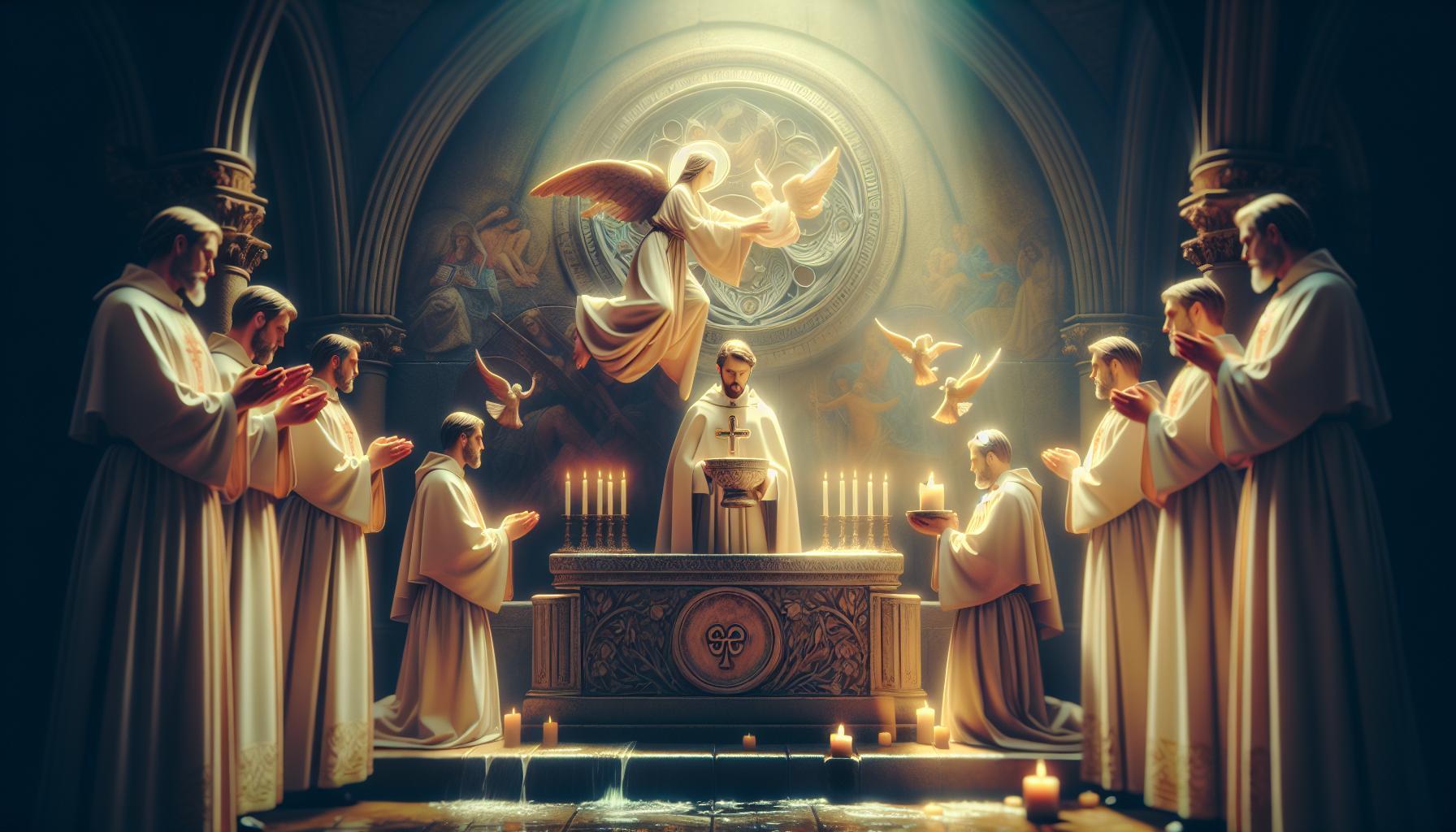Understanding the distinctions between baptism and christening is essential for anyone navigating Christian traditions. While both rituals celebrate a person’s entry into the faith, they serve different purposes and involve unique practices. Clarifying these differences not only fosters deeper appreciation but also guides families in choosing appropriate ceremonies for their loved ones.
Understanding the Foundations: Theology Behind Baptism and Christening
Understanding the diverse practices surrounding baptism and christening reveals profound theological distinctions that are crucial for believers and those seeking spiritual understanding. While both terms are often used interchangeably, they encompass unique meanings and implications based on doctrinal beliefs and religious traditions. Central to this discussion is the understanding that baptism serves as a sacrament and a rite of initiation, signifying a person’s commitment to the faith and marking a significant milestone in their spiritual journey.
Theological Foundations of Baptism
Baptism is recognized as one of the key sacraments within Christianity, instituted by Jesus Christ. It embodies not only a visible sign of God’s grace but also the concept of spiritual rebirth, as individuals publicly declare their faith and commitment to Christ. The apostle Paul emphasizes the importance of this sacrament by stating that there is “one Lord, one faith, one baptism” (Ephesians 4:5), underscoring the unity it represents within the Christian community. For many denominations, baptism initiates a believer’s journey, integrating them into the life of the Church and solidifying their identification with both Christ and the broader Christian faith1.
Conversely, various theological perspectives shape the understanding of baptism across different traditions. For instance, the Roman Catholic Church views baptism not only as a sign of faith but as an essential means of grace that can confer salvation even to infants, independent of personal faith at the time of the sacrament. This belief is articulated through the principle of “ex opere operato,” which posits that the efficacy of the sacrament is rooted in the ritual itself rather than the recipient’s personal disposition2.
The Nature of Christening
Christening, on the other hand, is predominantly understood as a ceremonial aspect of baptism, often involving the naming of a child and the blessing that accompanies it. Many denominations, especially within the Anglican Church, perceive christening as a form of initiation into the Christian faith, typically for infants. This practice often aligns with a commitment by the child’s parents or godparents to raise the child within the faith community, symbolizing both the church’s responsibility and the family’s spiritual obligation.
One key theological difference between baptism and christening lies in the implications of each term. While baptism signifies the sacramental act intended to cleanse away original sin and bestow grace, christening often focuses more on the communal and familial dimensions of welcoming a new member into the faith. This distinction aids in understanding why some traditions may perform christenings at different stages of a child’s life—reinforcing the significance of community support and faith development as integral to their spiritual journey.
Throughout Christian teachings, both baptism and christening play critical roles in marking the beginning of a believer’s spiritual life, yet their understanding is deeply influenced by doctrinal nuances, church teachings, and cultural practices. Ultimately, these rites serve as a powerful reminder of faith commitments made publicly and the spiritual journey that each individual embarks upon within their respective communities.
The Key Differences: Terminology and Traditions Explored

The distinctions between baptism and christening can be intricate, particularly because they often intertwine within various religious traditions. Understanding these differences is essential for parents, guardians, and individuals looking to participate in either ritual. At its core, baptism typically emphasizes the act of spiritual cleansing, marking an individual’s entry into the Christian faith through a ceremony that prominently features water. In contrast, christening is more specifically associated with the naming of a child and is often part of the baptismal process.
Baptism: A Deeper Religious Significance
Baptism is recognized as a sacred rite across many Christian denominations. It serves as a powerful declaration of faith and signifies the washing away of sin. This ceremony often takes place in various stages of life, from infancy to adulthood, emphasizing the individual’s understanding of their faith. Importantly, baptism is not only about the act itself but also the commitment one makes to uphold their faith in the Christian community. It commonly involves a godparent or sponsor who supports the baptized in their spiritual journey.
Christening: The Naming Ceremony
Christening, while closely linked to baptism, fundamentally serves as the naming ceremony for infants. During this rite, the child is typically given their name in a religious setting, highlighting their introduction into the faith community. Unlike baptism, christening may not universally involve the same emphasis on sin and personal commitment, especially in traditions where it is seen more as a cultural waiting period than a spiritual awakening. As a result, many people mistakenly believe that christening is equivalent to baptism when, in fact, it represents a unique, albeit related, event.
Key Differences at a Glance
| Baptism | Christening |
|---|---|
| Focuses on spiritual cleansing and the forgiveness of sins | Primarily a naming ceremony for children |
| Involves water as a significant element | May not necessarily involve water |
| Authenticates one’s entry into the Christian faith | More cultural, marking an introduction into the faith community |
| Typically requires understanding from the individual being baptized | Takes place often for infants who do not yet understand the faith |
In summary, while both rituals hold profound cultural and spiritual significance within Christianity, their purposes and meanings diverge considerably. Understanding these differences can help families make informed decisions about their religious practices and the significance of such ceremonies in their lives.
Similarities in Practice: Exploring the Shared Rituals

Both ceremonies share profound spiritual significance and often elaborate rituals that bring families together in celebration. Understanding these interactions can help illuminate the question, “Is a Baptism the Same as a Christening? Differences and Similarities,” particularly in their shared practices that emphasize community and faith.
### Shared Rituals
While baptism primarily focuses on the act of cleansing sins and welcoming individuals into the faith, christening involves an essential naming component. Both ceremonies may include similar liturgical elements, such as:
- Water Rituals: Both involve the use of water, symbolizing purification and new life.
- Prayer: Central to both practices, prayers are offered to invoke blessings upon the individual being baptized or christened.
- Community Involvement: Family and friends typically gather, uniting in shared faith and support during these significant life events.
- Religious Significance: Both rituals serve as important milestones in the spiritual journey of the individual, reinforcing the community bonds within the church.
### Purpose and Intent
Though their specific intents diverge—with baptism focusing on spiritual rebirth and christening centering on identity—the overlapping ceremonies capture the essence of welcoming a new member into the faith community. For many, the events signal a commitment not only to the individual but to the ideals and teachings of Christianity. This dual purpose enhances the familial data around a child’s upbringing within a faith framework, as seen in many cultures where these practices occur.
In conclusion, while exploring the question, “Is a Baptism the Same as a Christening? Differences and Similarities,” it becomes clear that the similarities in practice highlight a rich tapestry of faith, community, and shared values. By appreciating both the unique aspects and common threads within these rituals, families can better nurture their spiritual traditions and foster a sense of belonging.
Denominational Perspectives: How Different Faiths View Baptism and Christening

Understanding how various faiths view baptism and christening reveals much about their theological foundations, traditions, and cultural practices. While many people may refer to these ceremonies interchangeably, different denominations attribute distinct meanings and importance to each term. For instance, baptism is often viewed as a sacrament or ordinance in many Christian traditions, marking a significant spiritual event in an individual’s faith journey.
Catholic Perspectives
In the Catholic Church, baptism is essential for entry into the Christian community. It not only involves the use of water but also includes the naming of the child, often referred to as christening. This duality emphasizes that baptism is both a spiritual purification and a naming ceremony, serving to bestow a Christian identity. The Modern Catholic Dictionary defines christening specifically as conferring the sacrament of baptism while giving the individual a Christian name. This naming aspect is especially integral, as the child is welcomed into the faith community, with godparents often chosen to guide their spiritual upbringing [[3]](https://thepuregift.com/christening-vs-baptism/).
Protestant Views
Many Protestant denominations, such as Baptists and Methodists, differentiate between baptism and christening more starkly. For Baptists, baptism is a public declaration of faith and is performed on individuals who are old enough to personally affirm their beliefs. In this context, the act of baptism symbolizes a conscious choice to follow Christ, making the concept of christening less relevant. Conversely, many Methodists see baptism as a means of grace and often perform it for infants, similar to the Catholic tradition, but they may not emphasize the naming aspect to the same degree.
Orthodox Traditions
In Orthodox Christianity, baptism is considered vital for spiritual rebirth. The Orthodox Church performs a rich ritual involving triple immersion in the name of the Father, Son, and Holy Spirit. The concept of christening here is also included within baptism, as it often involves the giving of a name, traditionally taken from saints. This practice emphasizes both the community’s role and the individual’s connection to the church through historical and spiritual lineage.
Conclusion
In summary, while the terms baptism and christening may appear interchangeable, their meanings and importance vary significantly across different denominations. Each tradition incorporates its theological principles and cultural nuances that shape the individual’s experience and communal understanding of these sacred rites. Understanding these perspectives aids in appreciating how faith informs the rituals of welcome into the Christian community.
The Role of Community: Celebrating New Beginnings Together

The celebration of new beginnings is deeply rooted in the traditions of many communities, often drawing participants into a warm embrace of shared experience and mutual support. In many faiths, significant milestones such as baptism or christening serve as pivotal moments, marking a transformative chapter in an individual’s spiritual journey. While the terms are sometimes used interchangeably, understanding their distinct significance can deepen our appreciation of these rituals and their communal impact.
Baptism, often viewed as a rite of initiation, symbolizes the washing away of sin and the beginning of a new life aligned with faith. In various Christian denominations, baptism signifies entry into the community of believers, fostering a sense of belonging and kinship. Meanwhile, christening specifically refers to the naming ceremony often performed alongside baptism, embodying a promise of nurturing the individual’s familial and spiritual growth. These rites emphasize not only personal transformation but also the community’s role in supporting the individual’s spiritual journey.
Community Involvement in Celebrations
Communities come together to celebrate these moments, reinforcing bonds and shared values. Family members, friends, and fellow congregants partake in the festivities that often accompany such events:
- Preparation Assistance: Family and friends can assist with planning, from venue selection to decorations.
- Spiritual Guidance: Pastors or church leaders can provide teachings related to the significance of the ritual.
- Catering and Celebrations: Communities often contribute food or host celebrations that follow the service.
- Ongoing Support: The community commits to supporting the individual and their family on their spiritual journey.
This collaborative approach not only enhances the celebration but also solidifies the ties that hold the community together, fostering a supportive environment for all members. Being part of such gatherings can be an enriching experience, making individuals feel seen and valued, which is essential in celebrating new beginnings.
Furthermore, the act of publicly affirming one’s faith and identity in the presence of family and community can significantly strengthen an individual’s connection to their roots and beliefs. This communal aspect of baptism and christening invites everyone involved to reflect on their spiritual journeys, creating a shared narrative that connects generations as they journey through life together.
Personal Reflections: The Spiritual Significance of Baptism and Christening
Baptism and christening are often intertwined in the minds of many, yet each holds distinct spiritual significance that warrants exploration. At its core, baptism is a foundational sacrament in Christianity that represents a profound commitment to faith, often accompanied by the use of water as a symbol of purification and rebirth. As individuals or families embark on this spiritual journey, they may find themselves reflecting on personal beliefs, community ties, and the enduring legacy of faith throughout generations.
The Essence of Baptism
Baptism serves as a rite of passage, marking the entry of an individual—often an infant—into the Christian community. This act is imbued with deep spiritual meaning, symbolizing not just the cleansing of sin but also a welcoming into a larger faith community. For many, the experience of being baptized evokes feelings of joy, connection, and commitment. Parents feel a profound sense of responsibility to raise their children within the teachings of Christianity, instilling values that shape their moral compass and spiritual development.
Understanding Christening
Christening, on the other hand, primarily centers around the naming aspect that occurs during a baptism ceremony. While the act of christening may include baptism, its focus is distinct, highlighting the importance of receiving a Christian name which often carries family significance or reflective of a saint’s name. This moment can be seen as both a blessing and a commitment to uphold the values encapsulated in that name. Families frequently draw on the occasion to gather and celebrate, fostering relationships among relatives and friends while reinforcing a collective identity bound by faith.
- Personal Growth: Reflecting on one’s baptism can lead to personal growth and deeper faith understanding.
- Community Engagement: Engaging with the church community post-baptism strengthens social bonds.
- Legacy and Tradition: Participating in these ceremonies allows individuals to connect with family history and tradition.
This exploration of both baptism and christening illuminates how these sacred moments can guide personal and spiritual journeys. They prompt individuals and families to consider not just their own beliefs but also the wider implications of faith commitments. Through the rituals of baptism and christening, they can forge a meaningful legacy that resonates with both historical significance and personal experiences in their lives.
Preparing for the Ceremony: What to Expect and How to Participate
The anticipation surrounding a baptism can be both thrilling and daunting. From the ceremonial decorations to the heartfelt speeches, each aspect adds to the significance of this sacred rite. Understanding what to expect during the ceremony helps ensure that both participants and attendees can engage fully, creating a meaningful experience that celebrates faith, community, and the journey ahead.
What to Expect During the Ceremony
Typically, a baptism will include a series of structured components that reflect its religious importance. For Christians, this usually involves scripture readings, prayers, and the actual baptism rite, where water is used to symbolize purification and spiritual rebirth. Depending on religious denominations, this ritual could take place in a church, at home, or even outdoors. Attendees might witness an officiant recite blessings while the person being baptized, whether an infant or an adult, is either sprinkled with water or immersed, signifying their entry into the faith community.
- Welcome and Opening Remarks: A warm introduction usually begins the ceremony, thanking guests for their presence.
- Prayer: The officiant often leads a prayer to bless the occasion and invoke the Holy Spirit.
- Baptism Rite: The central act where water is used to baptize the individual.
- Closing Blessing: The officiant ends with a prayer and blessings for the baptized and their family.
How to Participate Actively
Participation can enrich the baptism experience for everyone involved. Attendees are encouraged to engage through the following actions:
- Arrive Early: Being punctual allows time to settle in and reflect on the ceremony’s significance.
- Dress Appropriately: Respecting the occasion with suitable attire shows reverence for the baptism ritual.
- Participate in Prayers and Songs: If the officiant invites guests to join in prayers or hymns, actively participating helps foster a sense of community.
- Offer Support: Following the ceremony, expressing congratulations and support to the baptized and their family reinforces the communal bond.
Additionally, it’s essential to respect the specific traditions and customs of the denomination, such as whether godparents are chosen or the role of family members during the ceremony.
By attending a baptism, you are not just a witness to a critical moment in faith; you are actively participating in a celebration of new beginnings, love, and spiritual commitment that resonates with the shared values of the community.
Guidance for Parents: Nurturing Faith Beyond the Ceremony
Welcoming a child into a faith community through baptism or christening is a momentous occasion, but the spiritual journey should not end with the ceremony. Parents play a crucial role in nurturing their children’s faith beyond the initial rites, ensuring that the values and teachings associated with these sacraments become an integral part of daily life. By actively engaging in your child’s spiritual development, you lay a strong foundation for a lifelong connection to their faith.
Embrace a Regular Spiritual Practice
Creating a routine that incorporates aspects of faith can significantly influence a child’s understanding and appreciation of spirituality. Here are some practical steps to consider:
- Family Prayer: Set aside time each day for family prayers, helping your child understand the importance of communication with God.
- Bible Stories: Engage your child with age-appropriate Bible stories. Make this a fun and interactive time by discussing the morals and lessons.
- Community Involvement: Participate as a family in church activities or social services to show the value of community and compassion.
By weaving these practices into daily life, parents can ensure that the significance of baptism or christening is felt continuously, reinforcing a child’s understanding of their religious identity.
Cultivate an Environment of Love and Support
The atmosphere in which children grow up plays a significant role in their spiritual development. It’s important to foster a loving and supportive home where discussions about faith are welcomed and encouraged. You can do this by:
- Encouraging Questions: Create a safe space for your children to ask questions about faith, spirituality, and their beliefs. This shows them that exploration and curiosity are part of the journey.
- Modeling Faith: Lead by example. Demonstrate your own faith through actions, such as kindness to others and gratitude in daily life.
- Celebrating Religious Milestones: Acknowledge and celebrate religious occasions and milestones to make faith a joyful part of your family’s life.
These actions not only reinforce the significance of baptism and christening but also invite children to take ownership of their faith journey.
Encourage Lifelong Learning
Education should not stop after the baptism or christening ceremony. Encourage your child to deepen their understanding of their faith through various resources:
- Sunday School and Youth Groups: Enroll your child in classes and groups designed for their age that focus on developing faith.
- Religious Literature: Provide access to books and materials that align with your faith’s teachings, allowing them to explore at their own pace.
- Ask Family and Friends: Involve godparents and family members in discussions about faith, allowing your child to see diverse perspectives within a shared belief system.
By actively participating in their religious education, parents can help their children understand that their journey of faith is ongoing and ever-evolving, transcending the singular event of baptism or christening.
Embracing this comprehensive approach—establishing regular practices, nurturing a supportive environment, and promoting lifelong learning—ensures that the spiritual significance of baptism and christening resonates deeply within the family, enriching every aspect of life for both parents and children alike.
Frequently Asked Questions
Is a Baptism the Same as a Christening? Differences and Similarities?
No, a baptism and a christening are not the same. Baptism is a ritual focused on spiritual cleansing, while christening usually refers to the naming ceremony often included in the baptism.
In many traditions, baptism symbolizes the washing away of sin and the initiation into the Christian faith. In contrast, christening historically emphasizes the naming of the child during this sacrament. While the terms are sometimes used interchangeably, their meanings and practices can differ significantly.
What is the significance of baptism?
Baptism is significant as it represents an individual’s commitment to the Christian faith and the cleansing of original sin. It is often viewed as a rite of passage within various denominations.
For many Christians, baptism is considered essential for spiritual rebirth and is performed with water, symbolizing purification. This act not only marks the beginning of one’s faith journey but also integrates the individual into the church community.
What happens during a christening ceremony?
A christening ceremony typically includes the naming of the child and may involve baptism. The priest or minister asks for the child’s name, incorporating it into the ritual.
This ceremony, while often inclusive of the baptismal rites, primarily places emphasis on the child’s name as part of the religious and familial identity. For a comprehensive understanding, consider exploring more about the different rites involved.
Why do some people confuse baptism and christening?
Many people confuse baptism and christening because the terms are often used interchangeably in everyday language, leading to misunderstanding of their true meanings.
This confusion arises especially in cultural contexts where christening is commonly referenced when discussing baby baptisms, despite the nuance in their definitions. Understanding these differences can help clarify their importance in Christian traditions.
Can adults be baptized or only infants?
Both infants and adults can be baptized. Traditionally, infants are baptized in certain denominations, while others, like Baptists, typically practice believer’s baptism, where individuals make a conscious decision.
Adult baptism signifies a deeper understanding of faith and personal commitment, showcasing a significant difference in baptismal practices across denominations. This diversity enriches the Christian tradition as a whole.
Is baptism required for salvation?
The necessity of baptism for salvation varies among denominations. Some believe it is essential, while others view it as an important but non-essential act of obedience.
In traditions such as Catholicism, baptism is often seen as a requirement, reflecting the belief in its cleansing power. Conversely, many Protestant sects emphasize faith alone as the criterion for salvation, viewing baptism primarily as an important declaration of faith.
Can I have a christening if I am not religious?
Yes, you can have a christening even if you are not highly religious. Many parents choose this rite for cultural or familial reasons.
A christening can serve as a meaningful way to celebrate a child’s identity within a community, regardless of one’s personal beliefs. It’s important to discuss expectations with the officiant to ensure the ceremony aligns with your values.
Insights and Conclusions
In exploring the question of whether a baptism is the same as a christening, we uncover important theological and practical distinctions that enrich our understanding of these sacred traditions. While both rites involve the act of welcoming individuals into the Christian faith, baptism is primarily recognized as a sacrament characterized by the believer’s commitment to Christ and inclusion within the Church community [2[2].
Understanding these differences invites a deeper appreciation of how various denominations interpret and practice these traditions. Baptism is emphasized as an essential step in one’s faith journey, as depicted in scripture, while christening may serve as a cultural or familial rite celebrating the new life in Christ [2[2].
As you reflect on these distinctions, consider engaging further with your faith community about their specific practices and beliefs regarding baptism and christening. Each ceremony offers a unique opportunity to connect with the spiritual and communal dimensions of Christianity. Whether you are investigating these rites for personal, familial, or communal reasons, both baptism and christening hold profound significance and can foster a deeper relationship with the faith. Embrace the journey of exploration as you seek to understand and participate in these cherished traditions.





